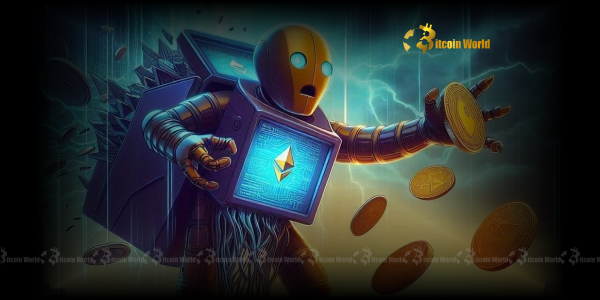BitcoinWorld

Arbitrum USDC Dominance: How 70% Fuels Hyperliquid’s Astonishing Growth
Have you been following the growth of stablecoins on Layer 2 networks? If so, you might be interested in a significant development on Arbitrum. The network’s deployment of USDC, known as Arbitrum USDC, has reached an impressive market capitalization of $5.2 billion. But here’s the intriguing part: a massive 70 percent of this substantial figure is reportedly concentrated on a single platform – the decentralized perpetuals exchange, Hyperliquid. This revelation, highlighted by @cryptounfolded on X, paints a vivid picture of liquidity dynamics within the Arbitrum ecosystem and the growing influence of specific DeFi protocols like Hyperliquid.
Understanding the Rise of Arbitrum USDC
The journey of Arbitrum USDC to a $5.2 billion market cap is a testament to the success of Arbitrum as a leading Layer 2 scaling solution for Ethereum. As gas fees on the Ethereum mainnet remain a consideration for many users, platforms like Arbitrum offer faster and cheaper transactions, making activities like trading, lending, and yield farming more accessible. This environment has naturally attracted significant liquidity, including stablecoins.
USDC, issued by Circle, is one of the most widely used and trusted stablecoins in the crypto space, known for its regulatory compliance and reserves. Its availability and deep liquidity are crucial for any thriving DeFi ecosystem. The decision by users and protocols to bridge and utilize USDC on Arbitrum reflects confidence in the network’s stability, security, and growing application landscape. The $5.2 billion figure places Arbitrum as a major hub for USDC activity outside of the Ethereum mainnet itself.
Several factors contribute to this growth:
- Lower Transaction Costs: Arbitrum significantly reduces the cost of transferring and using USDC compared to Ethereum L1.
- Faster Transaction Speeds: Quicker block times improve the user experience for trading and other high-frequency activities.
- Growing DeFi Ecosystem: A diverse range of protocols building on Arbitrum provides utility for USDC, attracting users and capital.
- Bridging Solutions: Robust bridges make it relatively easy to move USDC between Ethereum and Arbitrum.
Why is So Much Arbitrum USDC on Hyperliquid?
The most striking data point is the reported 70% of Arbitrum USDC being utilized on Hyperliquid. This isn’t just a large amount; it signifies a significant concentration of stablecoin liquidity on one specific platform. Hyperliquid is a decentralized perpetuals exchange, specializing in offering leveraged trading on various cryptocurrencies without relying on a traditional order book managed by a single entity. Instead, it often uses an Automated Market Maker (AMM) model or a similar mechanism tailored for perpetuals.
Here’s why Hyperliquid likely attracts such a large share of Arbitrum USDC liquidity:
- Focus on Perpetuals: Perpetual futures trading is a high-volume activity requiring deep liquidity to ensure efficient execution and minimal slippage, especially for large trades.
- Capital Efficiency: Decentralized perpetuals exchanges often allow users to deposit stablecoins like USDC as collateral for leveraged positions. The more USDC available, the greater the potential trading volume and capital efficiency on the platform.
- Yield Opportunities: Users might deposit USDC into liquidity pools on Hyperliquid to earn yield from trading fees paid by users opening positions. This provides an incentive beyond just trading.
- Performance: Being built on Arbitrum allows Hyperliquid to offer a trading experience closer to centralized exchanges in terms of speed and cost, which is crucial for active traders.
- Protocol Design: Hyperliquid’s specific design and features, such as its order matching engine or AMM model optimized for perpetuals, might be particularly effective at utilizing deposited USDC liquidity.
The concentration suggests that Hyperliquid is currently the dominant destination for users who want to actively deploy their Arbitrum USDC for trading or yield generation within the Arbitrum ecosystem’s perpetuals market.
The Role of Decentralized Exchanges in the Crypto Market
The growth of platforms like Hyperliquid highlights the increasing importance of Decentralized Exchange (DEX) protocols in the broader crypto market. DEXs allow users to trade cryptocurrencies directly with each other, peer-to-peer, without needing an intermediary to hold their funds. This aligns with the core ethos of decentralization and offers users greater control over their assets.
While initial DEXs primarily focused on spot trading (buying and selling assets for immediate delivery), the DeFi space has rapidly evolved to include more complex financial instruments, such as perpetual futures. Decentralized perpetuals exchanges face unique challenges, including managing liquidations, ensuring sufficient liquidity, and providing a performant trading experience on a blockchain.
Hyperliquid’s success in attracting significant Arbitrum USDC indicates it has found a compelling product-market fit within the decentralized perpetuals niche on Arbitrum. This sector of the Decentralized Exchange market is highly competitive, with protocols vying for liquidity and users by offering competitive fees, a wide range of trading pairs, and innovative features.
The rise of DEXs, particularly those handling leveraged products, is a key trend shaping the future of finance, offering alternatives to traditional centralized platforms. They represent a shift towards more transparent, programmable, and accessible financial markets.
Implications of High USDC Concentration
While Hyperliquid’s success in attracting Arbitrum USDC is a positive signal for the platform itself, such a high concentration also brings potential implications for the wider Arbitrum ecosystem and users:
Benefits:
- Deep Liquidity for Hyperliquid: The 70% concentration provides Hyperliquid with ample liquidity, leading to potentially tighter spreads, less slippage for traders, and a more robust trading environment.
- Validation for Arbitrum: It demonstrates Arbitrum’s capability to host large, capital-intensive DeFi applications successfully.
- Yield Opportunities: Users providing liquidity to Hyperliquid’s USDC pools can potentially earn significant yield from trading fees.
Challenges & Considerations:
- Concentration Risk: A significant portion of the network’s stablecoin value is tied to the performance and security of a single protocol. If Hyperliquid were to face technical issues, exploits, or smart contract risks, it could impact a large amount of Arbitrum USDC.
- Systemic Risk: Problems at Hyperliquid could potentially have ripple effects across other parts of the Arbitrum DeFi ecosystem that interact with or rely on Hyperliquid or its users.
- Limited Diversification: While USDC is being used, its use case is heavily skewed towards perpetuals trading on one platform, potentially limiting its availability or utility for other applications like lending protocols, spot DEXs, or yield farms on Arbitrum.
- Competitive Landscape: While dominant now, the perpetuals DEX space is dynamic. Maintaining this level of concentration will depend on Hyperliquid’s continued innovation and performance against competitors.
This high concentration is a double-edged sword, showcasing success but also highlighting a potential single point of failure or significant dependency within the Arbitrum DeFi landscape.
The Broader Stablecoin and Crypto Market Cap Context
Zooming out, the $5.2 billion Crypto Market Cap represented by Arbitrum USDC is a significant figure in the overall stablecoin landscape. While it’s only a fraction of the total USDC market cap (which often exceeds $25-$30 billion across all chains), it positions Arbitrum as a major Layer 2 network for stablecoin activity.
Stablecoins are fundamental infrastructure for the crypto market. They act as a bridge between volatile cryptocurrencies and traditional fiat currencies, provide a safe haven during market downturns, and are essential for trading, lending, and yield generation within DeFi. The distribution of stablecoin liquidity across different blockchains and Layer 2 solutions is a key indicator of where activity and innovation are happening.
The fact that a large portion of this Stablecoin value on Arbitrum is dedicated to leveraged trading on a Decentralized Exchange like Hyperliquid underscores the maturity and specific focus of the DeFi activity occurring on the network. It suggests that Arbitrum has become a preferred venue for more complex, capital-intensive trading strategies.
Understanding the flow and concentration of stablecoins like USDC is crucial for analyzing liquidity, identifying key protocols, and assessing potential risks within specific blockchain ecosystems and the broader Crypto Market Cap landscape.
Actionable Insights for Users and Investors
What does this concentration of Arbitrum USDC on Hyperliquid mean for you?
- For Traders: If you’re interested in perpetuals trading on Arbitrum, Hyperliquid is clearly a platform with deep liquidity. However, be aware of the risks associated with leveraged trading and using any single protocol.
- For Liquidity Providers: Opportunities to earn yield exist on Hyperliquid by providing USDC liquidity, but understand the specific risks of their liquidity pool model (e.g., impermanent loss variations, smart contract risk).
- For Arbitrum Users: Be aware of the dependencies within the ecosystem. While Arbitrum itself is robust, a significant issue at a major protocol like Hyperliquid could impact overall network sentiment and activity.
- For Investors: Analyzing where stablecoin liquidity flows provides insight into user behavior and dominant use cases on different chains. Hyperliquid’s success is notable, but evaluating its long-term sustainability and risk profile is important.
Diversification remains a key principle in crypto. While Hyperliquid offers specific opportunities, exploring the full range of DeFi protocols available on Arbitrum that utilize USDC is advisable.
Conclusion: Arbitrum USDC and Hyperliquid’s Intertwined Future
The statistic that 70% of the $5.2 billion Arbitrum USDC market cap powers Hyperliquid is more than just a number; it’s a powerful illustration of the current state of DeFi liquidity on Arbitrum. It highlights Hyperliquid’s remarkable success in capturing the stablecoin market for perpetuals trading and underscores Arbitrum’s position as a major Layer 2 hub.
This concentration brings significant benefits in terms of liquidity and trading efficiency on Hyperliquid, but it also introduces potential systemic risks for the Arbitrum ecosystem. As Arbitrum continues to grow and attract more users and protocols, observing how this stablecoin liquidity distribution evolves will be key. Will other protocols emerge to diversify the use cases for Arbitrum USDC, or will Hyperliquid continue to dominate as the primary destination for leveraging stablecoin capital?
The dynamic relationship between leading Layer 2 networks like Arbitrum, essential infrastructure like the Stablecoin USDC, and innovative Decentralized Exchange protocols like Hyperliquid will continue to shape the landscape of the broader Crypto Market Cap and the future of decentralized finance.
To learn more about the latest crypto market trends, explore our article on key developments shaping stablecoin institutional adoption.
This post Arbitrum USDC Dominance: How 70% Fuels Hyperliquid’s Astonishing Growth first appeared on BitcoinWorld and is written by Editorial Team





